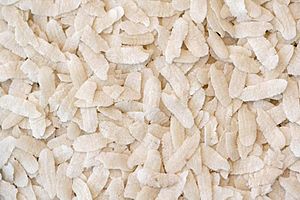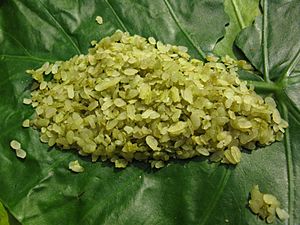Flattened rice facts for kids
Flattened rice is a special kind of rice that has been flattened into thin, light flakes. Imagine rice grains that have been squished flat! People make it from raw, toasted, or parboiled (partially cooked) rice.
These flat flakes can be eaten in many ways. You can eat them as they are, toast them, fry them, or add them to other foods as an ingredient or a topping. Depending on how they are prepared, they can be crispy, crunchy, chewy, or soft. They often have a mild, nutty taste. Flattened rice is a traditional food in many countries in Southeast Asia and South Asia where rice is grown. You might also hear it called rice flakes, beaten rice, pounded rice, or pressed rice.
Contents
Flattened Rice in South Asia

In South Asia, flattened rice is a very common breakfast food. It has many different names, like poha, pauwa, avalakki, chivda, or aval. It's especially popular in countries like India, Nepal, and Bangladesh.
To make poha, the outer husks are first removed from rice grains. Then, the rice is either parboiled or soaked in hot water for about 45 minutes. After that, it's dried, lightly roasted, and then flattened using rollers.
You can find poha in different thicknesses: thin, medium, and thick. The thinner types are great for cooking and making desserts. The thicker types are often used for deep-frying, which makes them super crunchy! Poha can be eaten as a quick snack or cooked into many different dishes that can be sweet, savory, or spicy.
Flattened Rice in Southeast Asia
Cambodia's Ambok
In Cambodia, flattened rice is called ambok. It's made by toasting newly-harvested rice (still with its husks on) in a large pan called a wok. Then, the warm rice is pounded flat using a big wooden mortar and pestle. After it's flat, the husks are removed.
Ambok is very important in Cambodia's Water Festival, which is called Bon Om Touk. People often eat it mixed with bananas, palm sugar, and coconut water. Sometimes, it's roasted with small shrimp for a savory treat.
Philippines' Pinipig
In the Philippines, flattened rice is known as pinipig. What makes pinipig special is that it's made from young, unripe glutinous rice grains. This gives it a unique greenish color.
First, the husks are removed from the rice. Then, it's pounded in a mortar with a pestle. After that, it's toasted or baked until it becomes crispy. Pinipig has a crunchy outside and a chewy center. People often eat it plain, use it as a topping for desserts and drinks, or bake it into delicious cakes.
A special kind of pinipig from Pampanga is called duman. The difference is that duman is toasted first before it's pounded. There's even a fun Duman Festival in Santa Rita, Pampanga each year to celebrate it!
Thailand's Khao Mao
In Thailand, flattened rice is called khao mao. Like the Philippine pinipig, it's made from young, unripe glutinous rice grains, so it's also green.
To make khao mao, the husked rice grains are soaked in water for several hours. Then, they are steamed in a bamboo container. After steaming, they are toasted in a wok and finally pounded flat in a mortar with a pestle.
Vietnam's Cốm
Flattened rice in Vietnam is known as cốm. It also has a green color. It's made by toasting young rice grains over low heat. Then, these grains are pounded flat in a mortar with a pestle. The husks are removed afterward by a process called winnowing, which uses wind to separate the light husks from the heavier rice.
Cốm can be eaten plain, used as an ingredient in other dishes, or made into cakes called bánh cốm. It's a popular food, especially during the Autumn season.
Myanmar's Mont San
In Myanmar, flattened rice is known as Mont San. In the southern part of Myanmar, it's sometimes offered to the sea water god 'U Shin Gyi'. Mont San is also enjoyed in the northern regions of Myanmar.
See also
 In Spanish: Poha para niños
In Spanish: Poha para niños



